History of Beth Jacob San Diego
History
Beth Jacob Congregation was founded in 1939. In May of that year, a small house on Myrtle Avenue was purchased for religious services and congregational meetings. In 1947, Rabbi Baruch Stern joined Beth Jacob and remained its rabbi until retiring in 1977. During Rabbi Stern's tenure, the Congregation built a new synagogue on 30th Street near Meade Avenue in 1950.
In 1972, Beth Jacob broke ground for a new synagogue located on College Avenue in proximity to San Diego State University. After several years and the dedication of many members of the congregation to see the synagogue finished, dedication services were held on August 28, 1977.
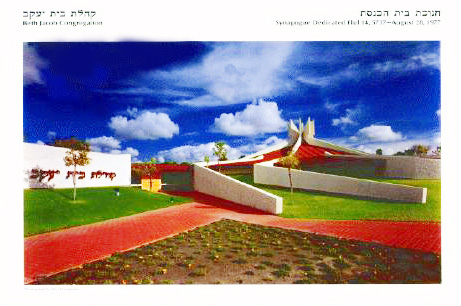
Beth Jacob Congregation's synagogue is an extraordinarily beautiful building. The above image was taken from the cover of the synagogue's dedication book. The images below are from photos of the four faceted glass windows located in the Beth Midrash and depict highlights from the Garden of Eden, Exodus from Egypt, building the Holy Temple, its destruction, the return and rebuilding of Israel.
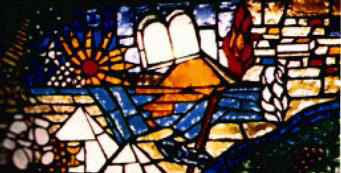
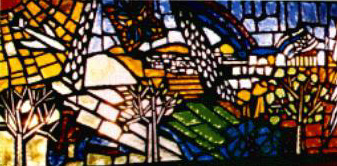
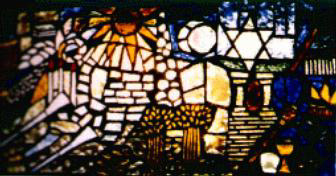
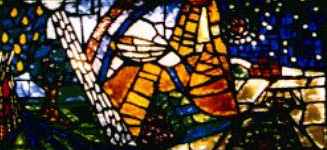
The panels also show the symbols of Shabbat and festivals. In the accomopanying text book celebrating 10 years on College Avenue, one learns that "the designer used rich colors and textures of one inch thick glass chipped at the edges in bold, mosaic style in a narrative flowing from one event and time to another. The symbols are superimposed upon each other. At sunset the faceted glass catches the sun's rays and basks worshippers in the rich colors of Jewish History."
Beth Jacob Congregation commissioned a postcard featuring the synagogue's sanctuary.
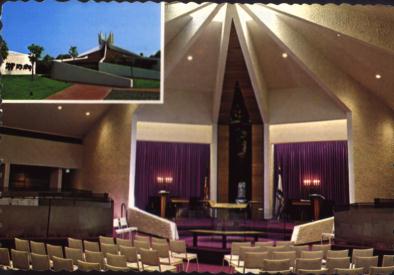
Beth Jacob is a proud member synagogue of the Orthodox Union.
I-8 Jewish Travel: Beth Jacob & the pomegranate

Roof of Beth Jacob Congregation resembles a pomegranate stem
Exit 10, College Avenue, San Diego ~ Beth Jacob Congregation
By Donald H. Harrison
SAN DIEGO—Approaching Beth Jacob Congregation, the first thing most people notice is the unusual protrusion from the red roof. No matter what might have been intended by the architect, Synagogue Administrator Rand Levin says the story is told at the Orthodox synagogue that it represents the stem of a pomegranate, which is a fruit rich in symbolism in the Jewish religion.
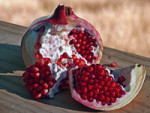
Pomegranate (Photo: Wikipedia)
Traditionally, a pomegranate is eaten on Rosh Hashanah—its seeds representing the fruitfulness with which one hopes the New Year is imbued. According to tradition, there are 613 seeds inside the pomegranate, exactly the same as the number of commandments, or mitzvoth, contained in the Torah.
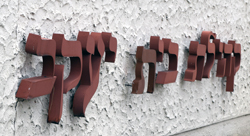
Textured walls and the congregation’s Hebrew name: Kehillat Beit Yakov.
In Levin’s view, the seeds of a pomegranate represent “all the various people inside. Not one, but many, bringing a sweetness to the congregation.”
Both on the inside and the outside, the walls of the synagogue are heavily textured, representing those times when Jews “wail and cry when we pray,” he said.
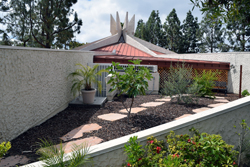 Israel Garden with five of the seven species at Beth Jacob Congregation
Israel Garden with five of the seven species at Beth Jacob Congregation
Triangular patches of ground provide areas for contemplation, recreation, and in the case of the Israel garden, more symbolism. Here are grown a real pomegranate tree, as well as a fig tree, olive tree, palm tree, and grapes – five of the seven species of Israel. “The only things we are missing are wheat and barley,” said Levin. “It has become a real serenity garden, if you will. People can sit here and schmooze.”
On another patch of ground is a small playground, providing a place of recreation for young and old throughout the week.
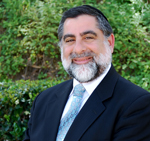
Rabbi Avram Bogopulsky
At the helm of Beth Jacob Congregation is Rabbi Avram Bogopulsky, only the third rabbi to serve there since it became an Orthodox institution after World War II. Beth Jacob Congregation and Center had been founded as a Conservative congregation in the late 1930s, but switched affiliations at the same time that the older Tifereth Israel Synagogue moved from the Orthodox to the Conservative movement.
Rabbi Baruch Stern, a survivor of the Holocaust who had trained as a Sunday school teacher at Tifereth Israel Synagogue during its Orthodox period, in 1947 became the first Orthodox rabbi of Beth Jacob. Up to his retirement in 1977, he permitted some of the congregation’s previous customs to continue, such as mixed seating. Rabbi Stern’s retirement coincided with the congregation’s move from a building on 30th Street in the North Park neighborhood of San Diego to its present location at 4855 College Avenue.
The next to lead the congregation was Rabbi Eliezer Langer, who hadmechitzahs installed in the new building to conform Beth Jacob with contemporary Orthodox practice. After he accepted an assignment in Israel, he was succeeded in 1996 by Rabbi Bogopulsky.
En route to ordination, Rabbi Bogopulsky studied under Rabbi Berel Wein and Rabbi Laibel Reznick at the Yeshiva Shaarei Torah in Monsey, New York. According to the congregation’s website, “it was the inspirational words and messages of Rabbi Wein that instilled with Rabbi Bogopulsky a desire to be of service to Klal Yisrael.”
Today, Rabbi Bogopulsky is aided by rabbinical assistant Pinchas (“Pinny”) Roth, who coordinates the educational component of the synagogue, specifically the Monday night “Partners in Torah” program in which a teacher and student are paired.
Other staff members include Yisroel and Malka Weiser, who lead the youth programs. Both also teach at Soille San Diego Hebrew Day School, Yisroel in fact being the son of the Jewish day school’s headmaster, Rabbi Simcha Weiser.
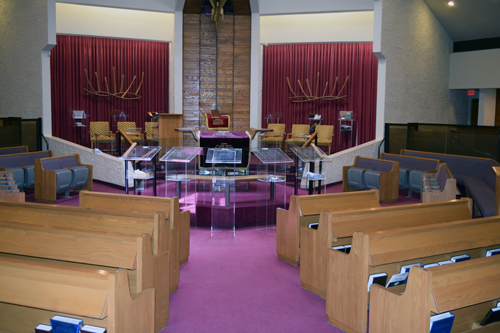 Beth Jacob Sanctuary
Beth Jacob Sanctuary
The Steiman Sanctuary, named posthumously for philanthropists Morrie and Barbara Steiman, seats 300 people with men in the middle and women on the two sides. As one might expect, the sanctuary is also rich in symbolism.
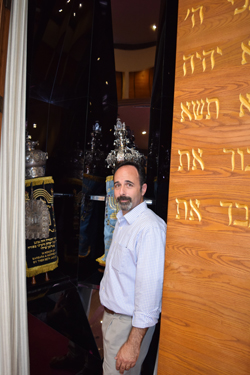 Rand Levin inside the Aron Kodesh of Beth jacob Congregation, 2015
Rand Levin inside the Aron Kodesh of Beth jacob Congregation, 2015
Upon the Aron Kodesh (Holy Ark) are engraved representations of the Ten Commandments, and when the doors are folded open to reveal the Torahs inside, the Ten Commandments appear on the fold-out sides of the doors as well, so that these words of God are always before the congregation.
Concerning the Ner Tamid, or Eternal Flame, “there is a legend that the glass ball at the top, which is visible, is attached to a motor that turns it to give the effect of a flame when light hits it,” Levin said. “I’m not sure if it true, we’ve never taken it apart to find the motor, but it was put here in 1977.”
On the walls on either side of the Holy Ark are large, matching, seven-branched menorahs. They were fashioned for the congregation after an electrical fire in a back room destroyed a wall of the sanctuary but not before Rabbi Langer and congregants were able to whisk the Torahs to safety.
Across from the Holy Ark is the Shulchan (or reader’s table) at which prayer leaders stand to recite prayers and read the Torah. The prayer leaders, like the congregation, face East during prayers. Reading stands, known asshtenders, enable congregants located at the front of the sanctuary to keep their siddurim (prayer books) and Chumashim (Bibles) within easy reach.
In the back of the room, paneled walls can open to enlarge the sanctuary for High Holy Day services and other occasions attended by larger-than-normal crowds. Otherwise these overflow spaces can be used for a variety of purposes, such as for study and rehearsals.
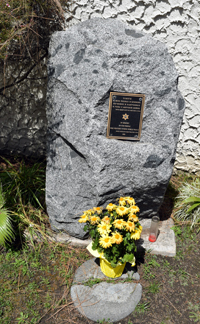 Russian memorial
Russian memorial
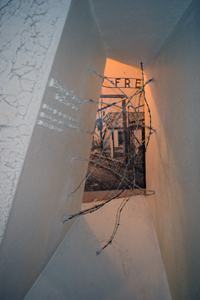 Wall niche symbolizing the concentration camps
Wall niche symbolizing the concentration camps
Both inside and outside, there are small memorials. One inside a wall niche is a photograph of the entrance to a concentration camp, with barbed wire in front of the photograph conveying some of the terror. In a garden, there is also a memorial erected by Russian-speaking members of the congregation to those who were lost in World War II.
Another important room in the Beth Jacob complex is the beit midrash, a study hall that also is used by daily minyans for prayer services. Along the back wall are four stained glass windows which, according to a description on the synagogue’s website, “depict highlights from the Garden of Eden, Exodus from Egypt, building the Holy Temple, its destruction, the return and rebuilding of Israel.”
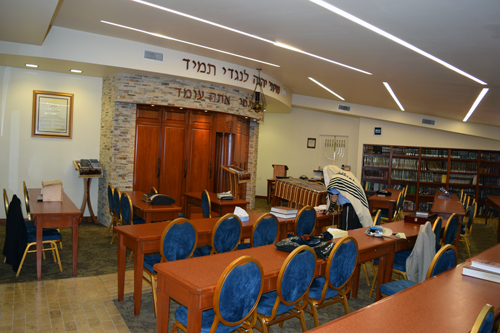 A man in solitary prayer in the Beit Midrash of Beth Jacob Congregation
A man in solitary prayer in the Beit Midrash of Beth Jacob Congregation
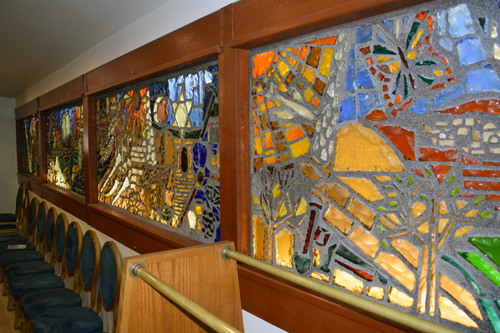 Stained glass windows beginning at right with a depiction of the Garden of Eden
Stained glass windows beginning at right with a depiction of the Garden of Eden
History and modernity, spirituality and pragmatism, exist side by side at Beth Jacob Congregation and Center, at which secular enterprises help to support a flourishing observant community that Levin estimates at 125 family units, with at least another 25 non-member families. “We don’t just service members, we service the entire Jewish community,” said Levin. “We hope those whom we serve who are not yet members someday will be.”
On the other side of the entrance foyer from the sanctuary is a large social hall, which is served by Beth Jacob’s own kosher kitchen. Approved kosher caterers are permitted to rent the kitchen, providing the synagogue another revenue stream. Rabbi Bogopulsky serves as the mashgiach for these uses.
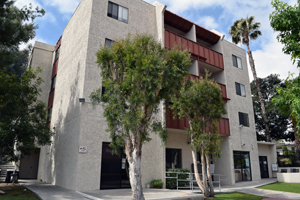 Rent from apartment units help financially to sustain Beth Jacob Congregation
Rent from apartment units help financially to sustain Beth Jacob Congregation
Having greater impact as a revenue source is a block of 50 apartments on the grounds of the Beth Jacob campus, which are rented not only to congregants wanting to be within an easy walk of services, but also to college students studying at nearby San Diego State University, and other occupants.
Levin said the apartments are “open to the public. We don’t discriminate, so there are many from the general population. It happens that about half the tenants have some connection to the synagogue, but we have Jews and non-Jews alike. It is a very diverse community.”
I asked if tenants can prepare non-kosher food.
“Absolutely,” he responded. “In the privacy of their own homes they can do what they want.”
For 14 years, Levin was a video journalist for KNSD, covering various news assignments in addition to serving as a co-producer for Ken Kramer’s popular “About San Diego” series, which also aired on the Public Broadcasting station, KPBS. After layoffs hit KNSD, Levin worked 4 ½ years for himself as a freelance video journalist, during which time he also served as the lay president of Beth Jacob Congregation.
“While I was president, I didn’t realize that I was training for my new career” as the synagogue’s administrator, he said.
As a boy, Levin had attended an Orthodox Day School and a Yeshiva in Los Angeles for one year, then completed his education at a public high school and at San Diego State University. His mother’s family was Orthodox, while his father was secular, he said.
“I moved to this community in 1998 and every day has been a day of spiritual growth for me,” said Levin.
Once Upon A Time in North Park . . . North Park Synagogues: Beth Jacob & Tifereth Israel
by Vickie Granowitz
In 1939, the Depression was beginning to show signs of ending, the citizens of the United States knew little of the man who would throw them into war. The Jewish community knew nothing of the desecration that would occur to their brethren in Europe. In San Diego, the small Jewish community believed its population would increase and that it was time to plan for the future. There were two synagogues in San Diego and both had downtown locations. Temple Beth Israel, the oldest San Diego synagogue, was established in 1861 as a Reform congregation. Tifereth Israel, established in 1905, was a Conservative congregation. San Diego was about to get its first Orthodox Synagogue. Judaism is divided into three basic groups.
The Orthodox adheres to the tenets of biblical law in a fundamental way. They practice their faith and lead their lives in ways similar to their ancestors 5000 years ago. They speak Hebrew at services, separate men and women during worship and always keep kosher. Reform Judaism has made many adaptations. Services are held mainly in English, men and women sit together and few keep kosher. Individuals who practice by Conservative rules are somewhere between Orthodox and Reform.
By May of 1939, a group of men and women who felt they needed an Orthodox approach to their Judaism had purchased a small house at 3206 Myrtle in North Park. They called their place of worship Beth Jacob Congregation. The small private home was hardly suitable, but the congregation grew steadily and the location was remodeled several times. The location included a Talmud Torah and a Religious School.
Following World War II, Beth Jacob Congregation was infused with a new enthusiasm and by March 20, 1950, land was purchased at 4473 30th Street near Meade Avenue. Three years later, ground was broken on the new location. In pictures from the groundbreaking ceremony, the North Park Water Tower is visible in the background. On December 6, 1953, the new Beth Jacob Synagogue and Center was dedicated. It had an auditorium with a 600 person capacity, school rooms and a fully equipped kosher kitchen.
Members of Tifereth Israel Synagogue also felt 1939 was the year to begin making changes. They had made changes many times and it had always led to positive results. From 1906 to 1917, they had occupied many rented locations. While World War I raged, they consecrated a location at Eighteenth and Market Streets and dedicated it to peace. In 1939 a group was formed to locate land and implement the construction of a larger, more appropriate facility. They held many fund raisers during the 1940s, and in 1948 they moved into a large corner lot at 30th and Howard in North Park. In August 1953, the congregation built a large two-story brick building as a Synagogue Center, next door to the temple. It included classrooms, a social hall, offices, a gift shop, kosher kitchen and an auditorium that contained a stage and an additional small kitchen.
With the rise of new suburbia, the upward mobility of San Diego residents and the need for larger quarters, the 1970s ended with North Park losing both their synagogues. Beth Jacob broke ground in 1972 and moved in 1977 to what had been a barren canyon close to San Diego State University. Tifereth Israel congregation also no longer fit in their North Park home, and by 1974, plans were underway to move. Their third and current home was dedicated in 1979. It is on Cowles Mountain on five acres of land in the suburb of San Carlos.
Today the buildings which had been built by the North Park Jewish community are inhabited by worshipers of other faiths.
Sun, May 5 2024
27 Nisan 5784
Download "The Weekly" Handout
UPCOMING EVENTS
There are no upcoming events at this time.
General Davening Schedule:
Weekday
Monday-Friday: 6:15am
Shabbos Shacharis - 8:45am
Sunday Shacharis - 8:00am
Daily Mincha/Maariv - per Shkiah (Sunset)
* Please view Weekly Link above for Afternoon times and/or special davening times.
Sign up For or manage Your Email Subscriptions
Zmanim for San Diego
| Alos Hashachar | 4:35am |
| Earliest Tallis | 5:08am |
| Netz (Sunrise) | 5:57am |
| Latest Shema | 9:20am |
| Zman Tefillah | 10:29am |
| Chatzos (Midday) | 12:45pm |
| Mincha Gedola | 1:19pm |
| Mincha Ketana | 4:43pm |
| Plag HaMincha | 6:08pm |
| Shkiah (Sunset) | 7:35pm |
| Tzais Hakochavim | 8:13pm |
| More >> | |



